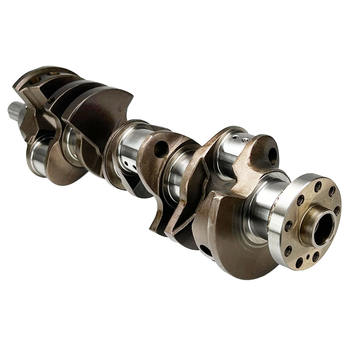
Crankshafts are the backbone of any internal combustion engine, converting the reciprocating motion of pistons into rotational energy that ultimately powers the vehicle. But with so many engine variations, what is the most common crankshaft design found in today's automobiles? While pinpointing one single "most common" design is difficult due to the vast array of engine configurations, we can explore the prevalent crankshaft types and materials to understand what dominates the market. This article will delve into the world of crankshafts, examining their critical role and dissecting the common characteristics found in modern engines.
Understanding Crankshaft Fundamentals
Before diving into the most common crankshaft configurations, it's crucial to understand the basics. A crankshaft is essentially a rotating shaft with offset "crank throws" or "crankpins" that connect to the connecting rods attached to the pistons. As the pistons move up and down within the cylinders, these crank throws convert the linear motion into rotational motion, driving the engine's output. The number of crank throws corresponds to the number of cylinders in the engine.
The Inline-Four and its Crankshaft
One of the most common engine configurations, especially in smaller vehicles, is the inline-four. This engine layout often utilizes a single-plane crankshaft. In a single-plane crankshaft, all the crankpins are positioned at 180 degrees to each other on the same plane. This design is relatively simple to manufacture and provides good balance for four-cylinder engines, making it a cost-effective and efficient choice. This prevalence contributes significantly to the argument that the single-plane crankshaft, used in inline-four engines, is a strong contender for the most common crankshaft.
Exploring Other Common Crankshaft Configurations
Beyond the inline-four engine, other configurations like V6 and V8 engines utilize different crankshaft designs. V-type engines often employ cross-plane crankshafts. In a cross-plane crankshaft, the crankpins are arranged in a different configuration, typically with 90-degree offsets between throws. This design can lead to a unique exhaust note often favored in performance vehicles, but it can also introduce more complex vibrations that require careful balancing. While not as common as the single-plane crankshaft found in inline-four engines, cross-plane crankshafts are prevalent in a large segment of the automotive market.
Crankshaft Materials: Strength and Durability
Regardless of the specific design, crankshaft materials play a vital role in their durability and performance. Most modern crankshafts are forged from high-strength steel alloys. Forging provides superior strength and fatigue resistance compared to casting, ensuring the crankshaft can withstand the immense forces generated within the engine. Some high-performance applications even utilize billet steel crankshafts, machined from a single solid block of steel, for ultimate strength and precise tolerances.
The Impact of Engine Design on Crankshaft Selection
The most common crankshaft design is heavily influenced by the prevailing engine configurations. The rise in popularity of smaller, more fuel-efficient engines, often inline-four configurations, contributes to the dominance of the single-plane crankshaft. However, the continued demand for larger, more powerful engines, particularly V-configurations, maintains the relevance of the cross-plane crankshaft.
Crankshaft Balancing and Engine Performance
Proper crankshaft balancing is crucial for smooth engine operation. Imbalance can lead to excessive vibrations, reduced performance, and premature wear of engine components. Manufacturers carefully balance crankshafts during production to minimize vibrations and ensure optimal engine performance. Have you ever considered the intricate balancing process required for these essential engine components?
Future Trends in Crankshaft Technology
As engine technology evolves, crankshaft design continues to adapt. The pursuit of lighter, more efficient engines is driving research into new materials and manufacturing processes. For instance, some manufacturers are exploring the use of composite materials to reduce crankshaft weight and improve engine responsiveness.
Troubleshooting Common Crankshaft Issues
While crankshafts are incredibly durable, they can experience issues over time. Common problems include bearing wear, journal damage, and even crankshaft breakage in extreme cases. Regular maintenance and timely repairs are crucial to prevent catastrophic engine failure.
Choosing the Right Crankshaft for Your Needs
When selecting a crankshaft, factors like engine configuration, performance goals, and budget play significant roles. Consulting with a qualified engine builder is essential for choosing the right crankshaft for a specific application. What are your primary considerations when choosing a crankshaft for a specific engine project?
Conclusion: The Ever-Evolving Crankshaft
While pinpointing the single "most common crankshaft" remains challenging due to the diversity of engine designs, understanding the prevalent types and materials provides valuable insights into the world of internal combustion engines. From the common single-plane crankshaft found in many inline-four engines to the more complex cross-plane designs used in V-configurations, the crankshaft remains a critical component, constantly evolving to meet the demands of modern engine technology. For further exploration, consider researching specific engine types and their corresponding crankshaft designs. This will provide a deeper understanding of the nuances and variations within the world of crankshafts.

 The Unseen Powerhouse: Unveili
The Unseen Powerhouse: Unveili
 Unveiling the Precision: The A
Unveiling the Precision: The A
 Navigating the World of Cranks
Navigating the World of Cranks
 The Unsung Heroes: What Makes
The Unsung Heroes: What Makes
